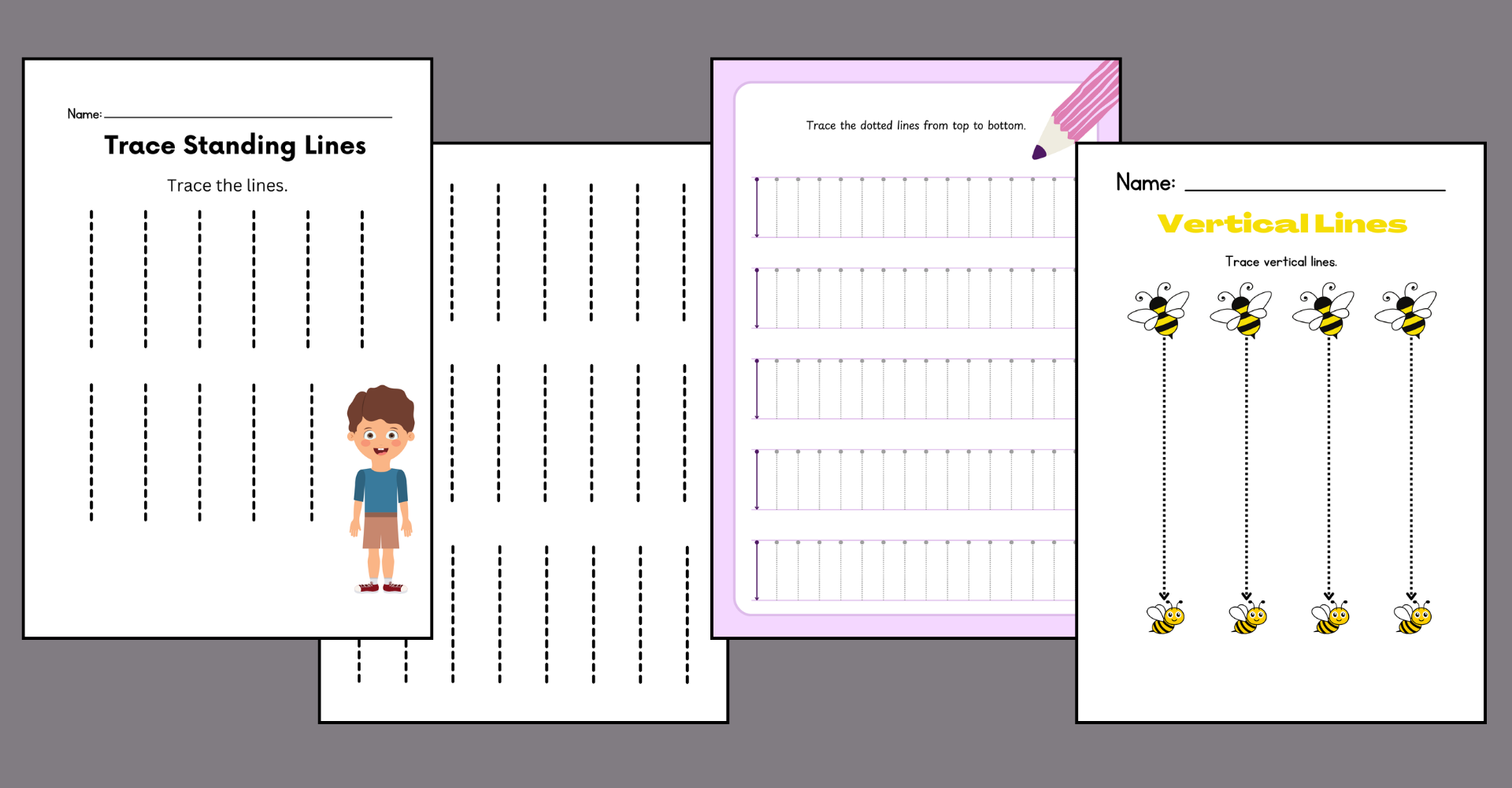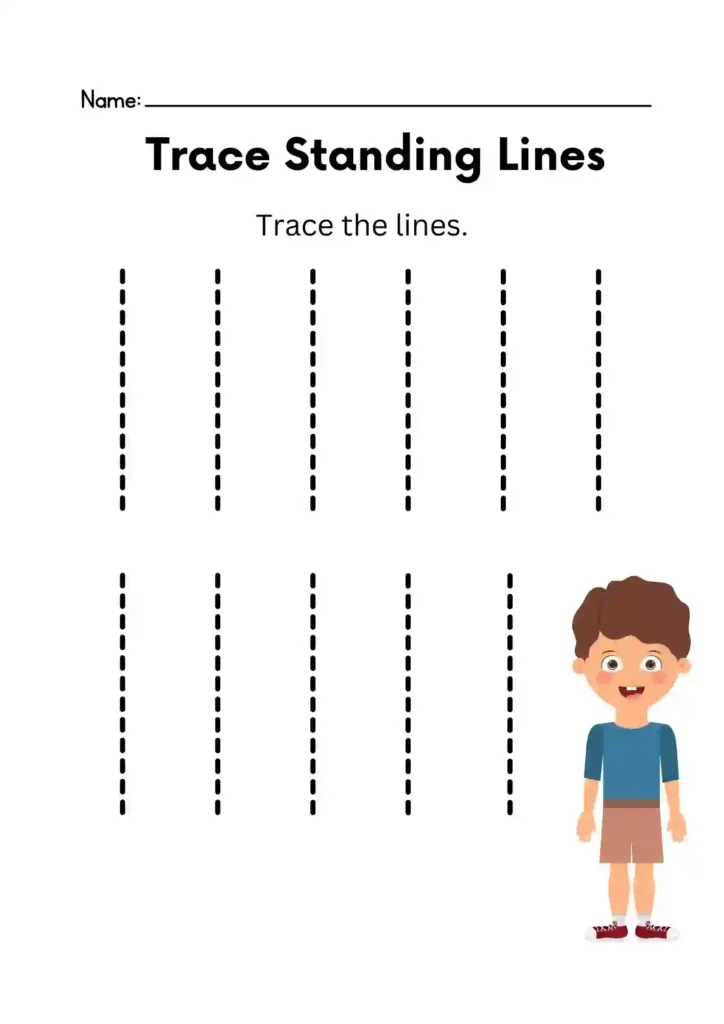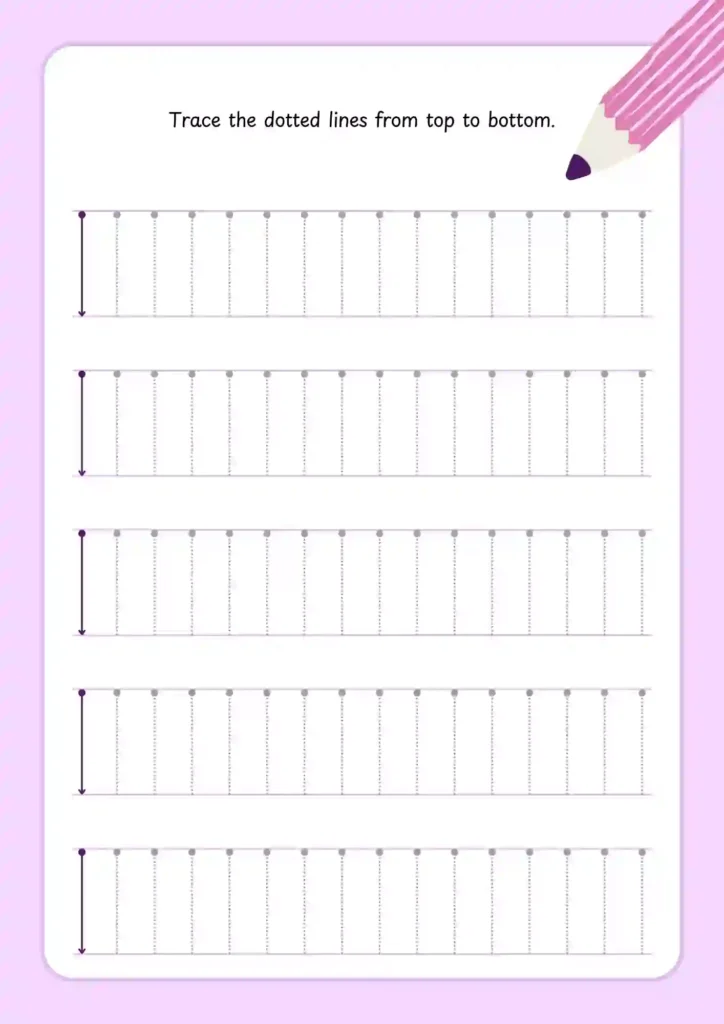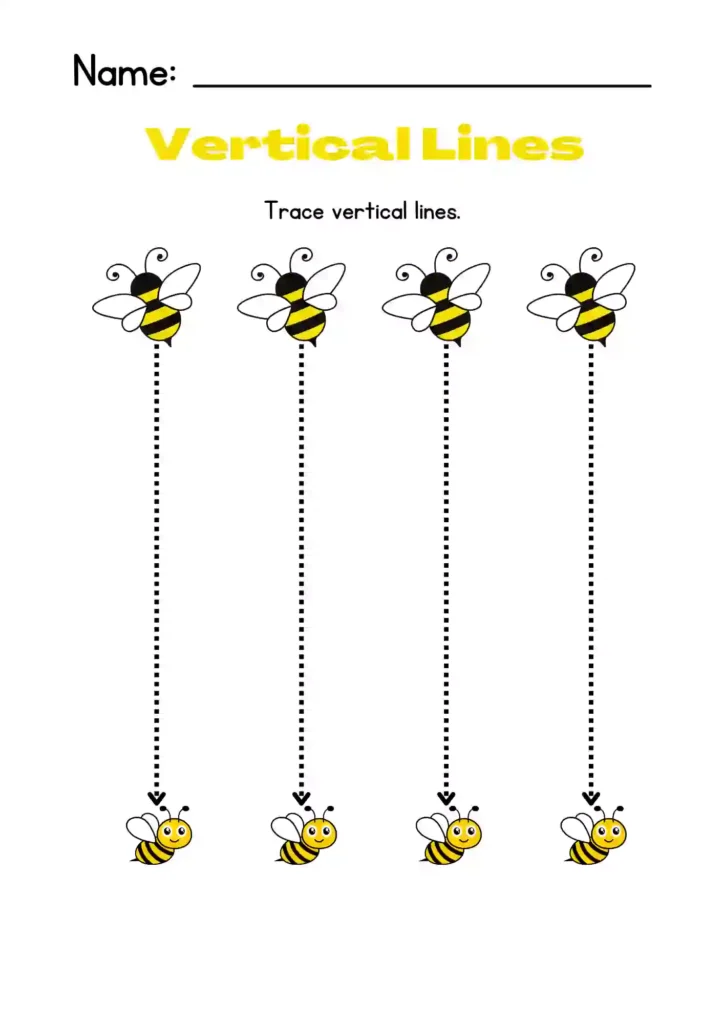Are you looking for engaging activities to help your nursery students master the art of tracing vertical lines? Give a Chance to our “Standing Line Worksheets for Nursery (PDF)”! These four carefully crafted worksheets are designed to make learning fun and interactive, ensuring your students develop essential fine motor skills and a strong foundation in pre-writing concepts.
Standing Line Worksheets for Nursery Details:
| Feature | Details |
|---|---|
| Format | Downloadable PDF |
| Number of Pages | 4 |
| Content | Activities focused on tracing vertical lines. |
| Illustrations | Yes, playful and age-appropriate |
| Suitable For | Nursery, Lkg & Ukg |
| Printable? | Yes, easy to print at home or in educational settings |
Learning Goals for Kids
Improve Hand Skills
When children trace vertical lines, they get better at using their hands and eyes together. This helps them learn how to hold a pencil or crayon properly.
Get Ready for Writing
By practicing with different line shapes, kids start to understand how to write. This practice is like building a strong foundation for their future writing skills.
Boost Attention and Focus
When kids take part in tracing activities, they learn to pay attention to what they are doing. This helps them concentrate better on their tasks.
Spark Creativity
Once children feel comfortable with tracing lines, they can start to draw and color. This is a wonderful way for them to express their ideas and creativity!
Who is this for?
This set of worksheets is suitable for the children in LKG, UKG, Nursery, preschool, and kindergarten, providing adaptable activities suitable for learning. They are perfect for use in both classroom settings and at home, providing a versatile resource for teachers and parents alike.
Materials Needed
To effectively use the standing line worksheets, you will need:
- Printed Copies of the Worksheets: Access the downloadable PDF versions.
- Crayons or Colored Pencils: Provide a variety of colors for children to use while tracing and coloring.
How to Use
Introduce the Activity
- Start with a Fun Question: Begin by asking the children if they can name things that are tall and straight. This will engage them and get them thinking about vertical lines.
- Use Visual Aids: Bring in pictures or even real objects that have standing lines, like a tall lamp or a flagpole. This will help them connect the concept to the real world.
- Interactive Discussion: Encourage the children to share what they see around them that has standing lines. This helps them become more observant and involved in the lesson.
Demonstrate
- Show Different Thicknesses: When demonstrating how to trace standing lines, show them lines of different thicknesses. Explain that standing lines can be thin like a pencil or thick like a tree trunk.
- Use Colorful Markers: Use bright colors when tracing to make it visually appealing. This can help keep the children engaged and excited about the activity.
- Explain the Process: As you demonstrate, explain each step clearly. For example, say, “Watch how I start at the top and go straight down. This is how we make a standing line!”
Guided Practice
- Group Tracing: Have the children trace lines together on a large piece of paper or a whiteboard. This way, they can see each other’s progress and learn from one another.
- Encourage Teamwork: Pair up the children and let them help each other as they trace. This promotes collaboration and allows them to learn from their peers.
- Positive Reinforcement: Praise their efforts as they trace the lines. Use phrases like “Great job!” or “Look how straight that line is!” to boost their confidence.
Independent Practice
- Provide a Variety of Worksheets: Give the children different worksheets with various standing lines to trace, including some that have fun shapes or characters at the end of the lines.
- Set a Timer: To make it more exciting, set a timer for a few minutes and challenge them to see how many lines they can trace in that time. This adds a fun element of competition.
- Encourage Creativity: After they finish tracing, invite them to create their own drawings using standing lines. This allows them to apply what they’ve learned in a creative way.
Review and Discuss
Wrap Up with a Fun Game: End the session with a quick game where you point to objects in the classroom and ask the kids to shout out if they see any standing lines. This reinforces their learning in a playful way.
Showcase Their Work: Create a mini-gallery by displaying their completed worksheets on a wall or board. This gives them a sense of pride in their work.
Reflect on the Activity: Ask questions like, “What was your favorite part of tracing the lines?” or “How did it feel to make straight lines?” This encourages them to think critically about their experience.
Connect to Future Lessons: Explain how standing lines are important in other activities, like drawing or writing. Let them know that they will use this skill in many different ways as they continue to learn.
Tips
- Use Pictures to Help Understand: Try using pictures of things that have straight standing lines, like trees or buildings. Showing these images can make it easier for kids to learn about lines.
- Get Moving with Lines: Encourage the children to stand up and use their fingers to draw vertical lines in the air. This fun activity helps them understand what vertical lines are by using their bodies to show the concept.
- Work Together with Friends: Pair up the children so they can trace lines together. This not only helps them learn but also gives them a chance to practice working with others and making friends.
- Sing and Learn: Create a simple song or chant about vertical lines. Singing helps kids remember what they’re learning and makes it more fun.
- Play Line Games: Set up games where the children have to identify vertical lines or move in vertical lines. Games make learning engaging and memorable.
Additional Activities for Kids
Line Art
Suggest to kids that they make their own pictures using straight up-and-down lines. For example, they could draw tall trees or skyscrapers by making lots of vertical lines next to each other. Encourage them to be creative and have fun making their own line art!
Story Time
Read storybooks that have really tall people or things in them. As you read, point out the straight lines in the pictures that show the tall objects or characters standing up. Talk about what you see in the illustrations and how the lines make things look tall. Reading together and discussing the pictures is a great way to learn about lines in a fun way!
Download the PDF File Here:
Click To Download the Standing Line Worksheets for Nursery PDF
See Other Line Tracing Worksheets for your kids!!
How to Print:
- Get the PDF: Start by clicking the link to download the PDF files of the worksheets.
- Set up Printing: Make sure your printer is all setup. You can adjust the settings like paper size, whether it’s portrait or landscape, and how clear you want the print to be.
- Check Before You Print: Take a print preview. To make sure everything looks just right before you hit print.
- Print: Once you’re happy with how it looks, go ahead and hit that print button.
Tips for Parents and Educators
- Give Positive Feedback: Always take a moment to celebrate what children do well. When you notice their hard work and effort, tell them! This will help them feel good about themselves and build their confidence. A simple “Great job!” or “I’m so proud of you!” can make a big difference.
- Encourage Daily Practice: Try to include fun tracing activities in your child’s daily routine. This could be as simple as tracing letters or shapes during playtime. Doing these activities every day will help them learn better and make it a regular part of their lives.
- Create a Fun Learning Environment: Make learning exciting and enjoyable by using bright colors and interesting materials. You can set up a special area with colorful books, art supplies, and games. Engaging activities, like drawing or crafting, can turn learning into a fun adventure that your child looks forward to!
Common Mistakes and Solutions
Trouble Drawing Straight Lines
- Use Whole Arm Movement: Encourage them to use their whole arm instead of just their wrist. This will give them better control over their pencil or crayon and help them create smoother lines.
- Practice with Guides: Provide them with lined paper or templates that have straight lines. This can help them practice following the lines and improve their skills over time.
- Fun Activities: Turn practice into a game! You could have them trace over straight lines with colorful markers or crayons, making it more enjoyable.
- Drawing Tools: Experiment with different drawing tools. Sometimes, using thicker crayons or markers can make it easier for children to control their movements and create straighter lines.
Losing Interest in Drawing
If your child seems to be losing interest in drawing or coloring, consider these strategies to keep them engaged:
- Variety of Materials: Introduce different types of drawing materials, such as colored pencils, chalk, or watercolor paints. A change in tools can spark new interest.
- Themed Activities: Create themed drawing sessions, like drawing their favorite animals, superheroes, or scenes from their favorite stories. This can make the activity more relatable and exciting.
- Interactive Games: Incorporate drawing games, such as Pictionary or collaborative drawing where you both draw parts of a picture. This adds a fun, social element to the activity.
- Art Challenges: Set up small challenges, like drawing something in under five minutes or creating a picture using only three colors. Challenges can make drawing feel like a fun competition.
How to Craft Your Own Standing Line Worksheets
Creating personalized worksheets can be a rewarding experience. Here’s how to make your own:
- Pick the Types of Lines: First, think about the different kinds of standing lines you want to include in your worksheets. You might want to use straight lines, zigzag lines, or even wavy lines. Choose a variety that will keep things interesting!
- Collect Images: Next, gather some images that show vertical lines. You can either find pictures online or draw your own. Look for fun and colorful images that will catch the kids’ attention.
- Design Your Worksheet: Now it’s time to design your worksheet. Create a simple and clean layout that is easy to read. Make sure to include clear instructions so that kids know what to do. You can use bright colors to make it more inviting!
- Test Your Worksheets with Kids: Finally, try out your worksheets with children. Watch how they interact with the activities and see what they enjoy the most. If something isn’t working well, don’t hesitate to make changes. This way, you can create the best possible experience for them!
Leave a Comment
We value your feedback! Share your experiences with the standing line worksheets in the comments below. Your insights help us improve our resources for young learners.
Love from LkgWorksheets!




